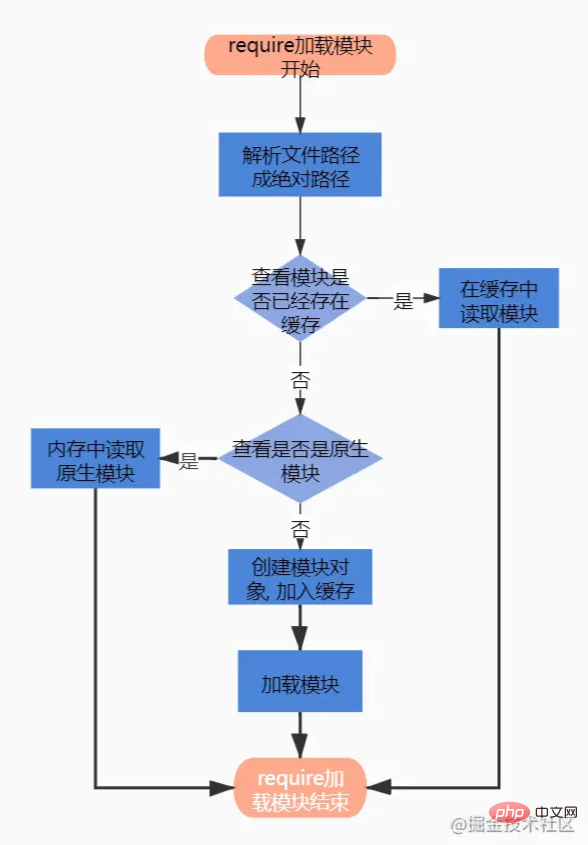한 기사로 Nodejs의 모듈 시스템을 빠르게 이해하세요
- 青灯夜游앞으로
- 2021-09-14 10:32:102721검색
이 기사는 Nodejs의 모듈 시스템을 안내합니다. 도움이 되기를 바랍니다!

모듈형 배경
초기 JavaScript는 간단한 페이지 상호작용 로직을 구현하는 데 사용되었지만, 시대가 발전하면서 브라우저는 단순한 상호작용을 표시할 수 있을 뿐만 아니라 다양한 웹사이트도 빛을 발하기 시작했습니다. 다른 정적 언어에 비해 웹사이트가 복잡해지고 프런트엔드 코드가 늘어나면서 이름 충돌 등 JavaScript의 모듈성 부족이 드러나기 시작합니다. 따라서 프런트 엔드 코드의 유지 관리 및 관리를 용이하게 하기 위해 커뮤니티에서는 모듈식 사양을 정의하기 시작했습니다. 이 과정에서 CommonJS, AMD, CMD, ES 모듈과 같은 많은 모듈 사양이 등장했습니다. 이 글에서는 CommonJS를 기반으로 Node에 구현된 모듈화를 주로 설명합니다. CommonJS, AMD, CMD, ES modules,本文章主要讲解Node中根据CommonJS实现的模块化。
CommonJS 规范
首先,在 Node 世界里,模块系统是遵守CommonJS规范的,CommonJS规范里定义,简单讲就是:
- 每一个文件就是一个模块
- 通过
module对象来代表一个模块的信息 - 通过
exports用来导出模块对外暴露的信息 - 通过
requireCommonJS 사양
우선 Node 세계에서는 모듈 시스템이 CommonJS 사양, CommonJS를 준수합니다. code> 사양 정의, 간단히 말하면:
- 각 파일은 모듈입니다
모듈개체를 통해 모듈 정보를 나타냅니다. 모듈을 내보내려면 -
require
내보내기를 사용하세요. 외부에 노출된 정보노드 모듈 분류
를 통해 모듈을 참조합니다. 핵심 모듈: fs, http, path 및 기타 모듈과 같은 모듈은 필요하지 않습니다. 런타임에 설치하려면 메모리에 이미 로드되어 있어야 합니다. [추천 학습: "
nodejs tutorial"]타사 모듈: 설치를 통해 node_modules에 저장됩니다.
사용자 정의 모듈: 주로 절대 경로 또는 상대 경로를 통해 도입되는 파일 모듈을 말합니다. CommonJS规范,我们先讲下module.exports与exports的区别。
首先,我们用个新模块进行一个简单验证
console.log(module.exports === exports); // true
可以发现,module.exports和epxorts实际上就是指向同一个引用变量。
demo1
// a模块
module.exports.text = 'xxx';
exports.value = 2;
// b模块代码
let a = require('./a');
console.log(a); // {text: 'xxx', value: 2}从而也就验证了上面demo1中,为什么通过module.exports和exports添加属性,在模块引入时两者都存在, 因为两者最终都是往同一个引用变量上面进行属性的添加.根据该 demo, 可以得出结论: module.exports和exports指向同一个引用变量
demo2
// a模块
module.exports = {
text: 'xxx'
}
exports.value = 2;
// b模块代码
let a = require('./a');
console.log(a); // {text: 'xxx'}上面的 demo 例子中,对module.exports进行了重新赋值, exports进行了属性的新增, 但是在引入模块后最终导出的是module.exports定义的值, 可以得出结论: noed 的模块最终导出的是module.exports, 而exports仅仅是对 module.exports 的引用, 类似于以下代码:
exports = module.exports = {};
(function (exports, module) {
// a模块里面的代码
module.exports = {
text: 'xxx'
}
exports.value = 2;
console.log(module.exports === exports); // false
})(exports, module)由于在函数执行中, exports 仅是对原module.exports对应变量的一个引用,当对module.exports进行赋值时,exports对应的变量和最新的module.exports并不是同一个变量
require 方法
require
에 대해 이야기한 후 node_modules 디렉토리까지 반복적으로 검색하는 내용을 기록한 배열입니다. CommonJS 사양, 먼저 module.exports와 exports의 차이점에 대해 이야기해 보겠습니다. 🎜🎜먼저 새 모듈을 사용하여 간단한 검증을 수행합니다🎜Module.prototype.require = function(id) {
// ...
try {
// 主要通过Module的静态方法_load加载模块
return Module._load(id, this, /* isMain */ false);
} finally {}
// ...
};
// ...
Module._load = function(request, parent, isMain) {
let relResolveCacheIdentifier;
// ...
// 解析文件路径成绝对路径
const filename = Module._resolveFilename(request, parent, isMain);
// 查看当前需要加载的模块是否已经有缓存
const cachedModule = Module._cache[filename];
// 如果有缓存, 则直接使用缓存的即可
if (cachedModule !== undefined) {
// ...
return cachedModule.exports;
}
// 查看是否是node自带模块, 如http,fs等, 是就直接返回
const mod = loadNativeModule(filename, request);
if (mod && mod.canBeRequiredByUsers) return mod.exports;
// 根据文件路径初始化一个模块
const module = cachedModule || new Module(filename, parent);
// ...
// 将该模块加入模块缓存中
Module._cache[filename] = module;
if (parent !== undefined) {
relativeResolveCache[relResolveCacheIdentifier] = filename;
}
// ...
// 进行模块的加载
module.load(filename);
return module.exports;
};🎜 module.exports와 epxorts가 실제로 동일한 참조 변수를 가리키는 것을 확인할 수 있습니다. 🎜🎜🎜demo1🎜🎜Module.prototype._compile = function(content, filename) {
// ...
const compiledWrapper = wrapSafe(filename, content, this);
//
result = compiledWrapper.call(thisValue, exports, require, module,
filename, dirname);
// ...
return result;
};🎜따라서 위의 demo1에서 속성이 모듈의 module.exports 및 exports를 통해 추가되는 이유 둘 다 존재합니다. 둘 다 궁극적으로 동일한 참조 변수에 속성을 추가하기 때문에 이 데모를 기반으로 결론을 내릴 수 있습니다. module.exports 및 exports code>는 동일한 항목을 가리킵니다. 참조 변수🎜🎜🎜demo2🎜🎜<pre class="brush:js;toolbar:false;">function wrapSafe(filename, content, cjsModuleInstance) {
// ...
const wrapper = Module.wrap(content);
// ...
}
let wrap = function(script) {
return Module.wrapper[0] + script + Module.wrapper[1];
};
const wrapper = [
&#39;(function (exports, require, module, __filename, __dirname) { &#39;,
&#39;\n});&#39;
];
ObjectDefineProperty(Module, &#39;wrap&#39;, {
get() {
return wrap;
},
set(value) {
patched = true;
wrap = value;
}
});</pre>🎜위 데모 예시에서 <code>module.exports가 재할당되고, exports에 새로운 속성이 늘어나는데, 모듈이 도입된 후에는 module.exports에 의해 정의된 값이 최종적으로 내보내지는 반면, noed 모듈은 최종적으로 module.exports를 내보내는 반면, exports는 단지 내보내기만 한다는 결론을 내릴 수 있습니다. 다음 코드와 유사한 module.exports에 대한 참조: 🎜// test.mjs
export default {
a: 'xxx'
}
// import.js
import a from './test.mjs';
console.log(a); // {a: 'xxx'}🎜함수 실행으로 인해 내보내기는 module.exports의 해당 변수에 대한 참조일 뿐입니다. code>module.exports, exports에 해당하는 변수는 최신 module.exports🎜🎜require 방법🎜🎜🎜require모듈을 도입하는 과정은 크게 다음 단계로 나누어집니다.🎜
- 解析文件路径成绝对路径
- 查看当前需要加载的模块是否已经有缓存, 如果有缓存, 则直接使用缓存的即可
- 查看是否是 node 自带模块, 如 http,fs 等, 是就直接返回
- 根据文件路径创建一个模块对象
- 将该模块加入模块缓存中
- 通过对应的文件解析方式对文件进行解析编译执行(node 默认仅支持解析
.js,.json, .node后缀的文件)
- 返回加载后的模块 exports 对象
.js,.json, .node后缀的文件)
Module.prototype.require = function(id) {
// ...
try {
// 主要通过Module的静态方法_load加载模块
return Module._load(id, this, /* isMain */ false);
} finally {}
// ...
};
// ...
Module._load = function(request, parent, isMain) {
let relResolveCacheIdentifier;
// ...
// 解析文件路径成绝对路径
const filename = Module._resolveFilename(request, parent, isMain);
// 查看当前需要加载的模块是否已经有缓存
const cachedModule = Module._cache[filename];
// 如果有缓存, 则直接使用缓存的即可
if (cachedModule !== undefined) {
// ...
return cachedModule.exports;
}
// 查看是否是node自带模块, 如http,fs等, 是就直接返回
const mod = loadNativeModule(filename, request);
if (mod && mod.canBeRequiredByUsers) return mod.exports;
// 根据文件路径初始化一个模块
const module = cachedModule || new Module(filename, parent);
// ...
// 将该模块加入模块缓存中
Module._cache[filename] = module;
if (parent !== undefined) {
relativeResolveCache[relResolveCacheIdentifier] = filename;
}
// ...
// 进行模块的加载
module.load(filename);
return module.exports;
};至此, node 的模块原理流程基本过完了。目前 node v13.2.0 版本起已经正式支持 ESM 特性。
__filename, __dirname
在接触 node 中,你是否会困惑 __filename, __dirname是从哪里来的, 为什么会有这些变量呢? 仔细阅读该章节,你会对这些有系统性的了解。
- 顺着上面的 require 源码继续走, 当一个模块加载时, 会对模块内容读取
- 将内容包裹成函数体
- 将拼接的函数字符串编译成函数
- 执行编译后的函数, 传入对应的参数
Module.prototype._compile = function(content, filename) {
// ...
const compiledWrapper = wrapSafe(filename, content, this);
//
result = compiledWrapper.call(thisValue, exports, require, module,
filename, dirname);
// ...
return result;
};function wrapSafe(filename, content, cjsModuleInstance) {
// ...
const wrapper = Module.wrap(content);
// ...
}
let wrap = function(script) {
return Module.wrapper[0] + script + Module.wrapper[1];
};
const wrapper = [
'(function (exports, require, module, __filename, __dirname) { ',
'\n});'
];
ObjectDefineProperty(Module, 'wrap', {
get() {
return wrap;
},
set(value) {
patched = true;
wrap = value;
}
});综上, 也就是之所以模块里面有__dirname,__filename, module, exports, require这些变量, 其实也就是 node 在执行过程传入的, 看完是否解决了多年困惑的问题^_^
NodeJS 中使用 ES Modules
- 在
package.json增加"type": "module"配置
// test.mjs
export default {
a: 'xxx'
}
// import.js
import a from './test.mjs';
console.log(a); // {a: 'xxx'}import 与 require 两种机制的区别
较明显的区别是在于执行时机:
- ES 模块在执行时会将所有
import导入的模块会先进行预解析处理, 先于模块内的其他模块执行
// entry.js console.log('execute entry'); let a = require('./a.js') console.log(a); // a.js console.log('-----a--------'); module.exports = 'this is a'; // 最终输出顺序为: // execute entry // -----a-------- // this is a
// entry.js console.log('execute entry'); import b from './b.mjs'; console.log(b); // b.mjs console.log('-----b--------'); export default 'this is b'; // 最终输出顺序为: // -----b-------- // execute entry // this is b
- import 只能在模块的顶层,不能在代码块之中(比如在
if代码块中),如果需要动态引入, 需要使用import()动态加载;
ES 模块对比 CommonJS 模块, 还有以下的区别:
-
没有
require、exports或module.exports在大多数情况下,可以使用 ES 模块 import 加载 CommonJS 模块。(CommonJS 模块文件后缀为 cjs) 如果需要引入
.js后缀的 CommonJS 模块, 可以使用module.createRequire()在 ES 模块中构造require函数
// test.cjs
export default {
a: 'xxx'
}
// import.js
import a from './test.cjs';
console.log(a); // {a: 'xxx'}// test.cjs
export default {
a: 'xxx'
}
// import.js
import a from './test.cjs';
console.log(a); // {a: 'xxx'}// test.cjs
export default {
a: 'xxx'
}
// import.mjs
import { createRequire } from 'module';
const require = createRequire(import.meta.url);
// test.js 是 CommonJS 模块。
const siblingModule = require('./test');
console.log(siblingModule); // {a: 'xxx'}-
没有 __filename 或 __dirname
这些 CommonJS 变量在 ES 模块中不可用。
-
没有 JSON 模块加载
JSON 导入仍处于实验阶段,仅通过 --experimental-json-modules 标志支持。
没有 require.resolve
没有 NODE_PATH
没有 require.extensions
没有 require.cache
ES 模块和 CommonJS 的相互引用
在 CommonJS 中引入 ES 模块
由于 ES Modules 的加载、解析和执行都是异步的,而 require() 的过程是同步的、所以不能通过 require() 来引用一个 ES6 模块。
ES6 提议的 import() 函数将会返回一个 Promise,它在 ES Modules 加载后标记完成。借助于此,我们可以在 CommonJS 中使用异步的方式导入 ES Modules:
// b.mjs
export default 'esm b'
// entry.js
(async () => {
let { default: b } = await import('./b.mjs');
console.log(b); // esm b
})()在 ES 模块中引入 CommonJS
在 ES6 模块里可以很方便地使用 import 来引用一个 CommonJS 模块,因为在 ES6 模块里异步加载并非是必须的:
// a.cjs module.exports = 'commonjs a'; // entry.js import a from './a.cjs'; console.log(a); // commonjs a
至此,提供 2 个 demo 给大家测试下上述知识点是否已经掌握,如果没有掌握可以回头再进行阅读。
demo module.exports&exports
// a模块
exports.value = 2;
// b模块代码
let a = require('./a');
console.log(a); // {value: 2}demo module.exports&exports
// a模块
exports = 2;
// b模块代码
let a = require('./a');
console.log(a); // {}require&_cache 模块缓存机制
// origin.js
let count = 0;
exports.addCount = function () {
count++
}
exports.getCount = function () {
return count;
}
// b.js
let { getCount } = require('./origin');
exports.getCount = getCount;
// a.js
let { addCount, getCount: getValue } = require('./origin');
addCount();
console.log(getValue()); // 1
let { getCount } = require('./b');
console.log(getCount()); // 1require.cache
根据上述例子, 模块在 require 引入时会加入缓存对象require.cache中。 如果需要删除缓存, 可以考虑将该缓存内容清除,则下次require模块将会重新加载模块。
let count = 0;
exports.addCount = function () {
count++
}
exports.getCount = function () {
return count;
}
// b.js
let { getCount } = require('./origin');
exports.getCount = getCount;
// a.js
let { addCount, getCount: getValue } = require('./origin');
addCount();
console.log(getValue()); // 1
delete require.cache[require.resolve('./origin')];
let { getCount } = require('./b');
console.log(getCount()); // 0结语
至此,本文主要介绍了 Node 中基于CommonJS实现的模块化机制,并且通过源码的方式对模块化的整个流程进行了分析,有关于模块的介绍可查看下面参考资料。有疑问的欢迎评论区留言,谢谢。
参考资料
Module Original Address : https://juejin.cn/post/7007233910681632781author : sloweat 더 많은 프로그래밍 관련 지식을 보려면 다음을 방문하십시오. !
위 내용은 한 기사로 Nodejs의 모듈 시스템을 빠르게 이해하세요의 상세 내용입니다. 자세한 내용은 PHP 중국어 웹사이트의 기타 관련 기사를 참조하세요!

